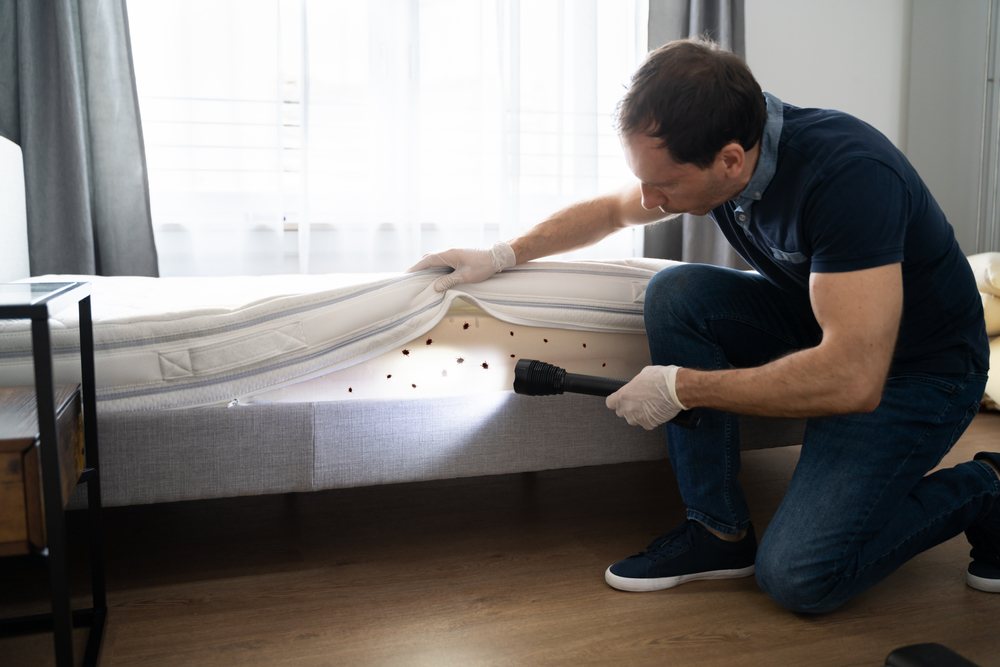Unfortunately, some household pests are harder to get rid of than you might think.
Bed bugs are one of them, as infestations are no laughing matter.
People come into contact with bed bugs by staying at an infected temporary residence (i.e. hotel) or moving to a new home that has bed bugs from a previous resident or nearby neighbor.
This happens because bed bugs spread easily, and infestations are challenging to remove.
Typically, your average bed bug’s lifespan is around 10 months from egg to end of adulthood.
This, coupled with a high reproduction rate, can make bed bug infestations a very real nightmare.
But with knowledge and preparation, you or a pest control professional can combat an infestation and eliminate these critters from for good.
Page Contents:
How Long Can Bed Bugs Live Without Food?
Bed bugs are resilient. They feed on human blood and can survive anywhere from 20 to 400 days without feeding.
If bed bugs can’t get access to human blood, they’ll also go for animal blood from mammals such as your pets, outside rodents, or farm animals as an alternative option.
But if deprived access to any mammalian blood source, an adult bed bug will most likely die in 2 to 3 months from starvation.
That timeframe is assuming temperate conditions (around 73 F or 23 C).
In lower temperatures, bed bugs’ metabolisms will slow down and elongate their lifespan. While bed bugs don’t like the cold, it takes close to freezing temperatures to effectively kill them.
Therefore the amount of time a bed bug can go without food depends on the temperature and humidity levels of their environment.
Baby bed bugs, referred to as nymphs, require more frequent feedings.
A nymph will shed its skin multiple times as it passes through the 5 growth stages before becoming an adult.
The egg to adult process takes about 37 days. As soon as bed bug eggs become nymphs, they’re able to begin feeding.
But because nymphs require more food to grow, they can die sooner than their adult counterparts if not given access to food.
The below video from bedbugsupply provides some additional detail on how long bed bugs can live without a meal.
How Long Can Bed Bugs Live in a Sealed Plastic Bag?
Sealing your items into plastic bags for extended periods of time is a common and ideal way to “quarantine” belongings afflicted with bed bugs.
It’s also a good way to ensure that all bed bugs are gone from your furniture and clothing before moving or traveling.
The length of time a bed bug can survive while sealed in a plastic bag is based on 2 key factors.
The temperature inside the bag and the size and type of plastic bag used.
Bed bugs can survive up to temperatures of 120 degrees Fahrenheit, so if the air inside the bag is hot enough, they will likely die.
Extreme cold is another option, so placing the plastic bag inside a freezer for at least a few days is another method of extermination.
Because bed bugs need little oxygen to survive, sealing them in a big bag is not an effective method for extermination.

If you’re bagging up items you believe contain bed bugs, you’ll need to leave them sealed for a few months to ensure enough time has passed and all bed bugs sealed inside are dead.
Can Bed Bugs Go Away on Their Own?
No. In most cases, bed bug infestations will not magically disappear.
As long as there is a consistent food source nearby, bed bugs will continue to feed and breed until that food source runs out.
Pest control services are needed for most bed bug infestations in apartments and homes.
Even if your apartment is left vacant for extended periods of time, bed bugs can still thrive by infesting your neighbors.
Bed bugs do this by crawling through cracks in the walls and baseboards.
How Long Do Bed Bugs Live Without Spraying?
There are some bed bug sprays you can try at home, but aerosols are less effective than professional methods. Sprays can’t permeate deep enough through fabrics to reach pests burrowed inside mattresses or couches.
So it’s best to call a pest control professional to deal with your situation.
It’s also important to be very careful if using pesticides in your home, as constant exposure can harm your children or pets.
For this reason, diatomaceous earth is considered a safe, do-it-yourself alternative to traditional pesticides.
But what is Diatomaceous Earth?
This is a soft, sedimentary rock that is sold in a white powder. It works to kill bed bugs and other insects by harming the insects’ shells when they crawl over the powdery substance.
Diatomaceous earth has a wide range of uses, and unlike other bed bug chemicals, it’s not harmful to humans or pets.
Spreading diatomaceous earth around the perimeter of infected rooms and into cracks/crevices where pests have been spotted is a good way to help curtail an infestation.
How Long Can Bed Bugs Live on Clothes?
Because dead skin cells and dried blood can transfer from your skin to your clothes, bed bugs can sometimes be found on your clothing.
Bed bugs can live for 1 to 4 months on your clothing without a meal. Though If you continue to wear clothes that are infested, bed bugs will continue to prey on your.

To rid your clothing of bed bugs, you’ll need to launder everything on the highest heat possible for both the washing and drying cycles.
After the dryer, immediately store the items in tightly-sealed plastic bags for an extended period of time until you’re sure the bugs are no longer alive inside.
This could take months, but quarantining any affected items is worth the wait to insure your home isn’t re-infected.
Most people begin using previously infested items prematurely…
Contributing to an average rate of recurrence of up to 80% in some cities.
How Long Can Bed Bugs Live Dormant?
Bed bugs have the ability to enter a hibernation state, or dormant state, called diapause.
However, bed bugs don’t enter diapause if they have access to a food source and stable temperatures.
If a bed bug does enter diapause, it can be dormant for up to 500 days.
(Though this is pretty rare).
Cooler temperatures allow bed bugs to stay alive longer, but temperatures of 0 degrees Fahrenheit or below will kill bed bugs when exposed for 4 days or more.
Can Bed Bugs Live in Your Car?
Yes. Like in your home, bed bugs can survive anywhere you are, because YOU are its primary food source.
If you have bed bugs in your vehicle, they have been transported into the car via you, your belongings, pets or family members.

Because of this, bed bug infestations in cars are rare, but still possible.
Keeping your vehicle clean and free of debris will help prevent the proliferation of infestations.
To identify bed bugs in your car, you should keep an eye out for the following signs.
- Tiny red blood stains on your seats or floors
- Dark spots that look like coffee grounds (bed bug excrement)
- Shell-like remains
- Small yellow eggs or eggshells
While bed bugs are resilient pests, it is possible to get rid of them.
You’ll have to be vigilant about quarantining or disposing of infected items, and you may even be eligible to sue your landlord if he/she is not offering an adequate solution.




